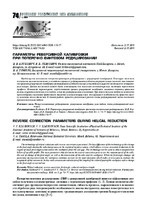| dc.contributor.author | Клубович, В. В. | |
| dc.contributor.author | Левкович, В. В. | |
| dc.contributor.author | Томило, В. А. | |
| dc.coverage.spatial | Минск | ru |
| dc.date.accessioned | 2020-04-03T10:52:43Z | |
| dc.date.available | 2020-04-03T10:52:43Z | |
| dc.date.issued | 2020 | |
| dc.identifier.citation | Клубович, В. В. Параметры реверсивной калибровки при поперечно-винтовом редуцировании = Reverse correction parameters during helical reduction / В. В. Клубович, В. В. Левкович, В. А. Томило // Литье и металлургия. – 2020. – № 1. – С. 74-77. | ru |
| dc.identifier.uri | https://rep.bntu.by/handle/data/70358 | |
| dc.description.abstract | Представлена технология поперечно-винтового редуцирования с реверсивной калибровкой. Ключевым отличием технологии является изменение угла подачи в процессе редуцирования в область отрицательных значений, что позволяет провести реверсивную калибровку (редуцирование в области малых углов подачи) и вывести заготовку из межвалкового зазора. Данная технология может быть использована для получения осесимметричных заготовок переменного профиля. Основными параметрами, определяющими процесс реверсивной калибровки, являются скорость вращения валков, скорость изменения угла подачи, а также размеры валков и заготовки. При изменении угла подачи (в частности при калибровке) заготовка продолжает движение в осевом направлении, что вызывает необходимость провести оценку величины этого движения. В данной работе проведен уточненный расчет длины редуцированной части заготовки при изменении угла подачи. | ru |
| dc.language.iso | ru | ru |
| dc.publisher | БНТУ | ru |
| dc.title | Параметры реверсивной калибровки при поперечно-винтовом редуцировании | ru |
| dc.title.alternative | Reverse correction parameters during helical reduction | ru |
| dc.type | Article | ru |
| dc.identifier.doi | 10.21122/1683-6065-2020-1-74-77 | |
| local.description.annotation | The technology of helical reduction with reverse correction is presented. The key difference of the technology is the change in the feed angle during the reduction process to the region of negative values, which allows reverse correction (reduction in the region of small feed angles) and remove the workpiece from the roll gap. This technology can be used to obtain axisymmetric billets of variable profile. The main parameters that determine the reverse correction process are the rotation speed of the rolls, the rate of change of the feed angle, as well as the dimensions of the rolls and the workpiece. When the feed angle changes (in particular during correction), the workpiece continues to move in the axial direction, which makes it necessary to evaluate the magnitude of this movement. In this work, an accurate calculation of the length of the reduced part of the workpiece with a change in the feed angle is carried out. | ru |

